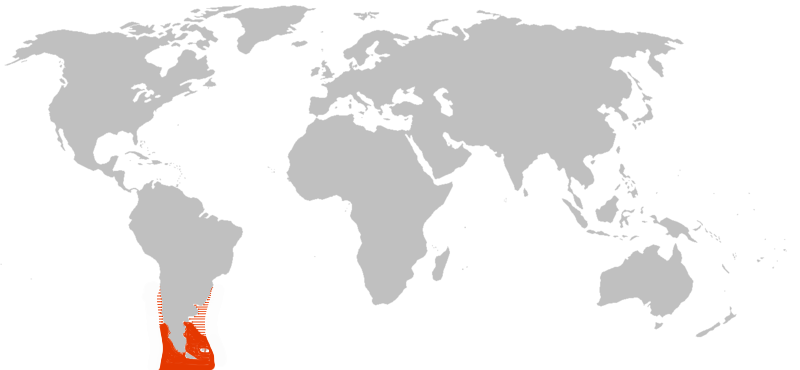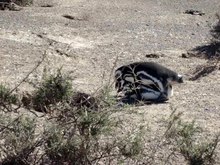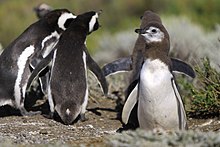
Description
Magellanic penguin on Argentina's coast
Swimming underwater at Berlin Zoo, Germany
Adults have black backs and white abdomens. There are two black bands between the head and the breast, with the lower band shaped in an inverted horseshoe. The head is black with a broad white border that runs from behind the eye, around the black ear-coverts and chin, and joins at the throat. Chicks and younger penguins have grey-blue backs, with a more faded grey-blue color on their chest. Magellanic penguins can live up to 25 years in the wild, but as much as 30 years in captivity.
Young birds usually have a blotched pattern on their feet, which fades as they grow up into adulthood. By the time these birds reach about ten years of age, their feet usually become all black.
Like other species of penguins, the Magellanic penguin has very rigid wings used to swim under water.
Diet
Magellanic penguins feed in the water, preying on cuttlefish, squid, krill, and other crustaceans, and ingest sea water with their prey. Their salt-excreting gland rids the salt from their bodies. Adult penguins can regularly dive to depths of between 20m to 50m deep in order to forage for prey. During the breeding season males and females have similar foraging and diving patterns as well as diet composition, however bone tissue analysis suggests that diets diverge post-season when limitations imposed by chick rearing are removed.[3]Magellanic penguins do not experience a severe shortage of food like the Galapagos penguins, because they have a consistent food supply being located on the Atlantic coast of South America. The presence of the large continental shelf in the Atlantic Ocean lets Magellanic penguins forage far from their breeding colony.[4]
Jellyfish including species in the genera Chrysaora and Cyanea were found to be actively sought-out food items, while they previously had been thought to be only accidentally ingested. Similar preferences were found in the Adélie penguin, yellow-eyed penguin and little penguin.[5]
Breeding
A couple of penguins copulating in their nesting site in Punta Tombo
Adults and chicks by their burrow in Cape Virgenes, Patagonia, Argentina
Magellanic penguins laid eggs in warm places where the temperature remain over 20℃.
Magellanic penguins mate with the same partner year after year. The male reclaims his burrow from the previous year and waits to reconnect with his female partner. The females are able to recognize their mates through their call alone.
Physiological responses
Newly hatched chicks that are visited by tourists show a stress response, with elevated levels of corticosterone in their blood. The elevated corticosterone is detrimental to the development of muscle strength, growth, and immune function.[9]Status in the wild
Magellanic penguins at the Patagonian coast
Climate change has displaced fish populations, so Magellanic penguins must swim an extra 40 km (25 miles) further from the nest for fish. While the penguins are swimming an extra 80 km (50 miles), their mates are sitting on a nest and starving. A colony being tracked by University of Washington professor P. Dee Boersma, about 1,600 km (1,000 miles) south of Buenos Aires, has fallen by more than 20 percent in the past 22 years, leaving 200,000 breeding pairs. Some younger penguins are now moving their breeding colonies north to be closer to fish, but, in some cases, this is putting them on private, unprotected lands. As a result of these changes, some penguins are known to have been lost or confused.[10] At present, 12 of 17 penguin species are experiencing rapid population declines. A recent study of professor Dee Boersma showed that an increase of rainstorms caused by climate change affecting weather patterns has had a large impact in the chicks' population. The chicks haven't yet grown waterproof feathers so they are more likely to die of hypothermia when they get wet during big storms.[11]
Increased frequency of extreme events, such as storms, drought, temperature extremes, and wildfires, associated with climate change, increases the reproductive failure in Magellanic penguins.[12]
Conservation
The provincial government of Chubut is committed to the creation of a MPA in order to protect the penguins and other marine species near the largest Magellanic breeding colony. The creation of a MPA would likely improve the breeding success of the colonies as well as increase prey availability, reduce foraging distance, and increase feeding frequency.[7](Forster, 1781)

Red area shows range






No comments:
Post a Comment
Note: Only a member of this blog may post a comment.